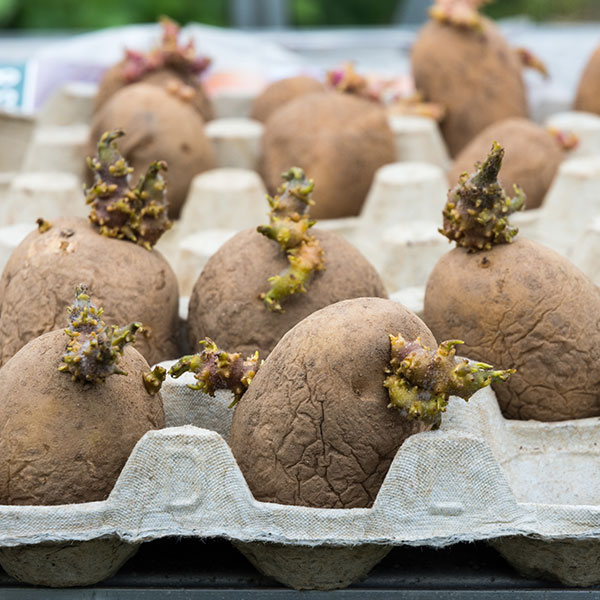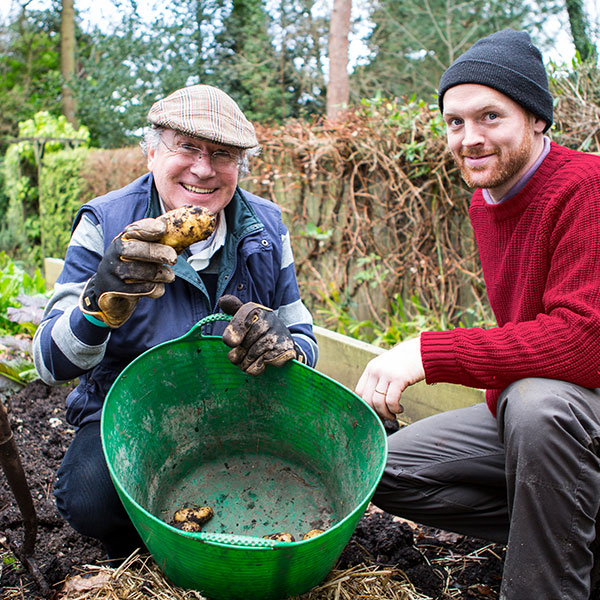How to grow your own potatoes
Is there anything better than growing your own spuds? Potatoes are easy to grow and give you loads of sensational spuds with fairly minimal effort! Not only this, they can be grown in the ground, in pots, or in grow bags, so you can grow your own potatoes almost anywhere - ideal for those with a balcony, patio, or step to play with. Follow these tips and you'll have a sackful of your own spuds in no time at all.
 By Rochelle
By Rochelle- 17th May 2022
- 8min read
- This blog was updated on 1st January 2025
What you’ll need
Before getting stuck in, make sure you’ve got these growing essentials to hand:
- Seed potatoes
- Compost
- Large plant pot
- Hand tools including a trowel and a hand fork for harvesting!
Choosing the right potato seed variety
Potatoes are grown from specifically prepared seed potatoes. They look just like the potatoes that you’d buy in the supermarket, but these ones have been certified virus-free and good to grow.
There are a few different types of potatoes you can grow, and they’re named after when you plant and harvest them. What you plant depends on what you want to eat (and when!):
- First earlies – plant between February and April ready to harvest in June and July
- Second earlies – plant between March and May ready to harvest in July and August
- Main crop – plant between March and May ready to harvest between August and October
First and second earlies produce tasty new potatoes that are perfect for steaming, boiling or adding to salads, whereas main crop produce bigger potatoes ideal for enjoying as baked potatoes, adding to a warming winter stew, or roasting.
Just one seed potato will produce many potatoes for harvest – they're the gift that keeps on giving!
Preparing your seed potatoes for planting – a guide to chitting
Chitting seed potatoes before planting them is important. Chitting refers to the ‘chits’ (the sprouts) of the potatoes and involves encouraging these shoots to grow from the potatoes.
To chit your seed potatoes, you’ll need to place them in a shallow tray (an egg box is perfect) in a light, cool and frost-free space, either indoors or in a greenhouse. Give them plenty of space and try to make sure that the side of the potato with most of the rose (the eyes) is facing upwards, as this is where the chits will come from.
Over the next few weeks, you’ll see shoots sprout from the potato. Your chitted seed is ready to sow when the shoots are around 3cm long.
Chitting your potatoes before planting them out makes them much more likely to produce plenty of tasty spuds, so don't miss this step out!

Now it’s time to plant
When to plant
Planting times for seed potatoes depends on the variety, weather, and growing conditions each year. Colder periods or areas might need to plant later whereas milder weather means they can be planted earlier. Here’s a rough guide to planting times:
- First earlies – around late March
- Second earlies – early to mid April
- Main crops – mid April to May
Take a look at the label on your chosen seed potatoes for more planting guidance.
Where to grow them
Potatoes need a sunny spot in your garden and should be planted where they’ll have some protection from frost if possible.
What to grow potatoes in
You can grow potatoes straight in the ground, just be sure to prepare the soil well and remove any weeds and debris.
For best results main crop potatoes grow best in the ground and early/salad potatoes grow well in containers or grow bags.
If sowing in the ground, a rough estimate is to sow main crop potatoes 37/38cm apart and earlies 30cm apart.
Using grow bags
No room for a veg patch? No problem! Potato grow bags will help you grow some yummy spuds anywhere. They're perfect for reusing every year, and they usually come with drainage holes so your soil won't get too waterlogged. Happy spuds, here we come!
Compost should take up around a third of your grow bag or container. The amount of potato seeds to grow depends on the size of the container, sowing one seed potato per bag will give bigger potatoes, whereas sowing two or three per bag will give more but smaller potatoes.
Growing in planters
When planting in planters, cover the base with about 10cm of compost, add in your seed potatoes, then cover the potatoes with another 10cm or so of compost and place in a warm sunny spot.
You can layer up potatoes this way, planting a couple of larger seed potatoes on the first layer then repeating the process with some smaller ones on another layer on top.
As shoots start to appear they’ll need protecting from light and frost damage. Once the stems are around 8cm tall, you’ll need to ‘earth them up’. If you’re growing in the ground, draw soil up around them to create a mound that’s about 15cm high. If you’re growing in a bag, simple pour some more compost in to cover the shoots every couple of weeks as they grow. This will also make sure your tatties aren’t exposed to light which would turn them green and nasty!
Clever Pots potato planter
Take the hassle out of growing and harvesting your potatoes with the Clever Pots potato planter. The potato pot allows you to grow up to three potato plants at once. It allows you to harvest your crop without upturning the whole plant too, so you can continue to grow potatoes for longer!
Start with the right compost
Give your potato seeds the best start with some nutritious compost to get them growing! Our range of compost has been specially developed to create the perfect growing conditions for your spuds.
Get the best from your crop
Potatoes are hungry plants, so some extra nutrients are always a good idea! Potato fertiliser, unlike some plant feed, is best added as part of ground preparation, so pop some of this down before planting.
Be sure to water potatoes regularly, especially during warm and dry spells, and keep the soil weed-free.
Top tip: Instead of fertiliser you could also use well-rotted organic matter like garden compost or manure.
Harvesting your super spuds
Harvesting times depend on the potato variety and weather conditions, but here’s a rough guide to help:
- First early potatoes should be ready to lift in June and July
- Second earlies in July and August
- Main crops from late August through to October
If you’re growing first early or second early potatoes, wait until the flowers open or the buds drop. The potatoes will grow until about the size of an egg. These don’t store that well so it’s best to eat them fresh.
With main crop potatoes, wait until the foliage turns yellow, then cut it down and remove it. This variety stores well and your harvested potatoes can be kept in a cool, dry place for a few months.
How to harvest? Potatoes are really easy to harvest, cut down the plant and prise it out of the ground with a harvesting tool such as a garden fork. If you’ve grown your potatoes in containers, simply tip the contents out of the container and remove the potatoes.
Top tip: If you’ve used the Clever Pots potato planter, there’s no need to upturn the plant, simply remove the internal pot and pick your potatoes as you need them - that’s a little win!
How long does it take to grow your own potatoes? This will depend on the variety of potato as well as weather and other growing conditions.
Which potatoes/variety of potatoes is the quickest to grow? First and second earlies tend to grow quicker than main crop potatoes, but again this is all dependant on lots of factors including weather and ground conditions as well as your chosen variety.

Common diseases and remedies
Potato blight – This is a common disease which tends to happen more in warm and wet weather. The leaves turn yellow/brown and the tubers start to rot. Earthing up your potato plants will help (mounding soil around the leafy shoots to their full height), but it’s difficult to stop once started. Growing blight resistant varieties is the best solution.
Potato scab – When harvesting potatoes some may have scabs on the surface. This doesn’t affect the taste of the potato but should be removed when peeling. Ensure the crops are well watered, as scabs are more likely to appear under drier conditions.
Rotting - To prevent rotting, try growing resistant potato varieties such as Cara. Keeping the soil from becoming overly wet or dry when planting and harvesting will help too.
Crop rotation - If growing in the ground, make sure to rotate your potato crops year on year. This means not growing potatoes in the same soil the following year, as this can lead to pest and diseases.
And that’s everything you need to know to get started, so let’s grow some super spuds! Share pics of your homegrown spuds with us on Facebook, Instagram, TikTok & X. We’d love to see them!